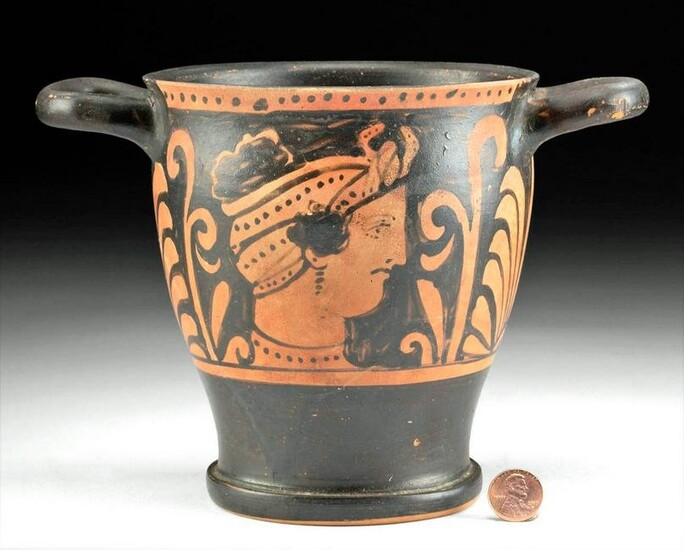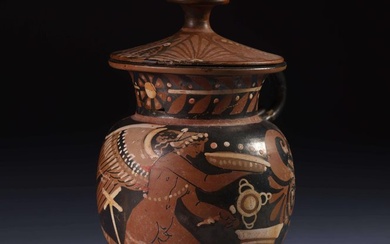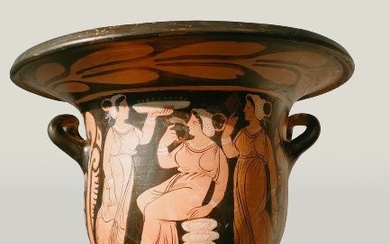Large Apulian Red Figure Skyphos w/ Ladies of Fashion
Magna Graecia, South Italic Colonies, Apulia, ca. 340 to 300 BCE. A sizable example of a wheel-thrown drinking vessel known as a kylix of a tall and broad form. The elegant vessel presents with a tapered cylindrical body resting atop a thick foot, a thin, slightly flared rim surrounding the deep basin, and a pair of parabolic handles emanating equidistantly from the sides. Thick areas of black glaze create the pair of finely dressed, red figure women who are aptly known as "ladies of fashion," each with a kekryphalos hairstyle, beaded earrings dangling from their earlobes, and beaded necklaces adorning their necklines. Each face - or perhaps depicting 1 woman from each side - exhibits a minimalist eye, a pointed nose above a downturned mouth, and a rounded chin, and each profile is separated by a large palmette frond beneath each handle. A register of black spots rings around the rim exterior and creates a sophisticated presentation. Size: 8.125" W at handles x 5.8" H (20.6 cm x 14.7 cm)
Perhaps the most exciting innovation in Greek vase painting was the red-figure technique, invented in Athens around 525 BCE and beloved by other artists of Magna Graecia. The red-figure technique allowed for much greater flexibility as opposed to the black-figure technique, for now the artist could use a soft, pliable brush rather than a rigid metal graver to delineate interior details, play with the thickness of the lines, as well as build up or dilute glazes to create chromatic effects. The painter would create figures by outlining them in the natural red of the vase, and then enrich these figural forms with black lines to suggest volume, at times perspectival depth, and movement, bringing those silhouettes and their environs to life.
Cf. The Metropolitan Museum of Art, accession number 76.12.15
Provenance: ex-Lone Jack, Missouri, USA collection, acquisition number 1984-EST
All items legal to buy/sell under U.S. Statute covering cultural patrimony Code 2600, CHAPTER 14, and are guaranteed to be as described or your money back.
A Certificate of Authenticity will accompany all winning bids.
PLEASE NOTE: Due to recent increases of shipments being seized by Australian & German customs (even for items with pre-UNESCO provenance), we will no longer ship most antiquities and ancient Chinese art to Australia & Germany. For categories of items that are acceptable to ship to Australia or Germany, please contact us directly or work with your local customs brokerage firm.
Display stands not described as included/custom in the item description are for photography purposes only and will not be included with the item upon shipping.
#169288
Condition Report: Repair to small area of lower body beneath right-facing female profile and stabilization to some surrounding fissures, with resurfacing and overpainting along break lines. Small nicks to rim, handles, interior basin surfaces, exterior walls, and foot, with light fading to glaze pigments in scattered areas, and a few small spalls. Nice craquelure in several areas and light silvery iridescence across most glazed surfaces. Old inventory number painted in black beneath foot.
View it on
Sale price
Estimate
Time, Location
Auction House
Magna Graecia, South Italic Colonies, Apulia, ca. 340 to 300 BCE. A sizable example of a wheel-thrown drinking vessel known as a kylix of a tall and broad form. The elegant vessel presents with a tapered cylindrical body resting atop a thick foot, a thin, slightly flared rim surrounding the deep basin, and a pair of parabolic handles emanating equidistantly from the sides. Thick areas of black glaze create the pair of finely dressed, red figure women who are aptly known as "ladies of fashion," each with a kekryphalos hairstyle, beaded earrings dangling from their earlobes, and beaded necklaces adorning their necklines. Each face - or perhaps depicting 1 woman from each side - exhibits a minimalist eye, a pointed nose above a downturned mouth, and a rounded chin, and each profile is separated by a large palmette frond beneath each handle. A register of black spots rings around the rim exterior and creates a sophisticated presentation. Size: 8.125" W at handles x 5.8" H (20.6 cm x 14.7 cm)
Perhaps the most exciting innovation in Greek vase painting was the red-figure technique, invented in Athens around 525 BCE and beloved by other artists of Magna Graecia. The red-figure technique allowed for much greater flexibility as opposed to the black-figure technique, for now the artist could use a soft, pliable brush rather than a rigid metal graver to delineate interior details, play with the thickness of the lines, as well as build up or dilute glazes to create chromatic effects. The painter would create figures by outlining them in the natural red of the vase, and then enrich these figural forms with black lines to suggest volume, at times perspectival depth, and movement, bringing those silhouettes and their environs to life.
Cf. The Metropolitan Museum of Art, accession number 76.12.15
Provenance: ex-Lone Jack, Missouri, USA collection, acquisition number 1984-EST
All items legal to buy/sell under U.S. Statute covering cultural patrimony Code 2600, CHAPTER 14, and are guaranteed to be as described or your money back.
A Certificate of Authenticity will accompany all winning bids.
PLEASE NOTE: Due to recent increases of shipments being seized by Australian & German customs (even for items with pre-UNESCO provenance), we will no longer ship most antiquities and ancient Chinese art to Australia & Germany. For categories of items that are acceptable to ship to Australia or Germany, please contact us directly or work with your local customs brokerage firm.
Display stands not described as included/custom in the item description are for photography purposes only and will not be included with the item upon shipping.
#169288
Condition Report: Repair to small area of lower body beneath right-facing female profile and stabilization to some surrounding fissures, with resurfacing and overpainting along break lines. Small nicks to rim, handles, interior basin surfaces, exterior walls, and foot, with light fading to glaze pigments in scattered areas, and a few small spalls. Nice craquelure in several areas and light silvery iridescence across most glazed surfaces. Old inventory number painted in black beneath foot.





